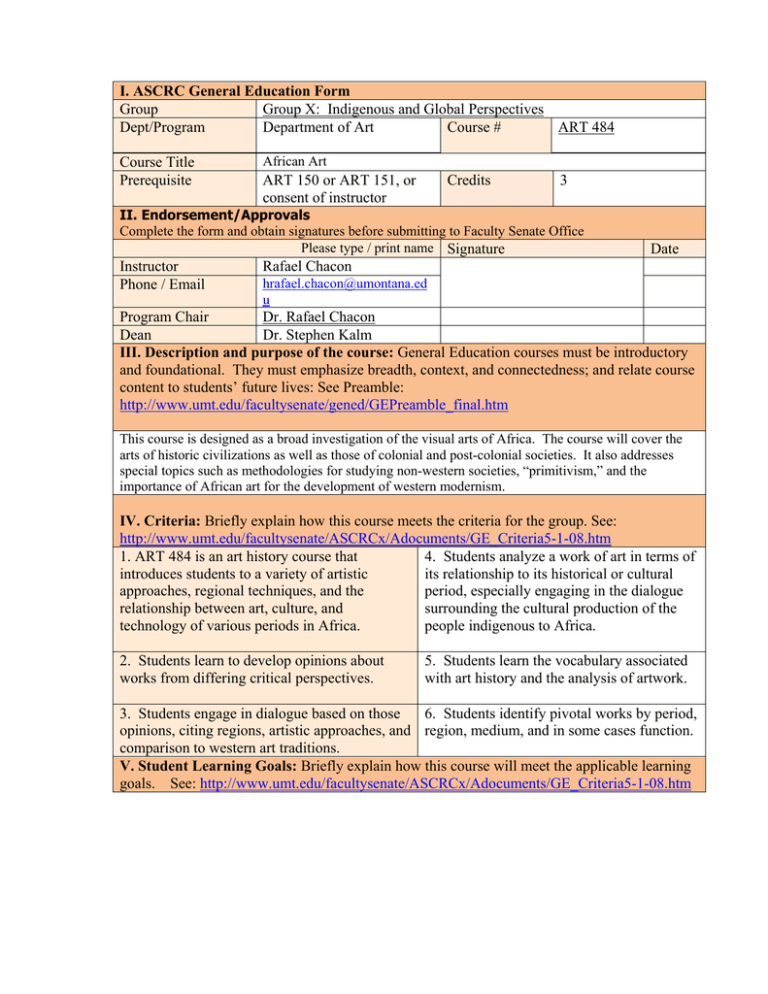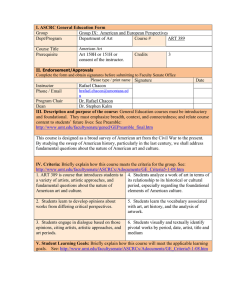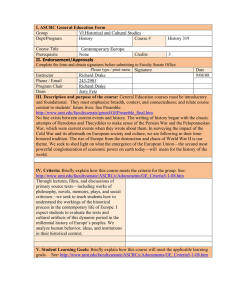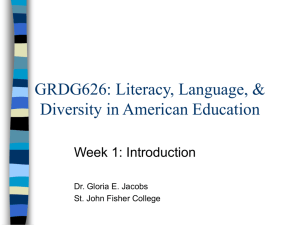I. ASCRC General Education Form Group Dept/Program
advertisement

I. ASCRC General Education Form Group Group X: Indigenous and Global Perspectives Dept/Program Department of Art Course # ART 484 Course Title Prerequisite African Art ART 150 or ART 151, or consent of instructor Credits 3 II. Endorsement/Approvals Complete the form and obtain signatures before submitting to Faculty Senate Office Please type / print name Signature Instructor Phone / Email Date Rafael Chacon hrafael.chacon@umontana.ed u Program Chair Dr. Rafael Chacon Dean Dr. Stephen Kalm III. Description and purpose of the course: General Education courses must be introductory and foundational. They must emphasize breadth, context, and connectedness; and relate course content to students’ future lives: See Preamble: http://www.umt.edu/facultysenate/gened/GEPreamble_final.htm This course is designed as a broad investigation of the visual arts of Africa. The course will cover the arts of historic civilizations as well as those of colonial and post-colonial societies. It also addresses special topics such as methodologies for studying non-western societies, “primitivism,” and the importance of African art for the development of western modernism. IV. Criteria: Briefly explain how this course meets the criteria for the group. See: http://www.umt.edu/facultysenate/ASCRCx/Adocuments/GE_Criteria5-1-08.htm 4. Students analyze a work of art in terms of 1. ART 484 is an art history course that its relationship to its historical or cultural introduces students to a variety of artistic period, especially engaging in the dialogue approaches, regional techniques, and the surrounding the cultural production of the relationship between art, culture, and technology of various periods in Africa. people indigenous to Africa. 2. Students learn to develop opinions about works from differing critical perspectives. 5. Students learn the vocabulary associated with art history and the analysis of artwork. 6. Students identify pivotal works by period, 3. Students engage in dialogue based on those opinions, citing regions, artistic approaches, and region, medium, and in some cases function. comparison to western art traditions. V. Student Learning Goals: Briefly explain how this course will meet the applicable learning goals. See: http://www.umt.edu/facultysenate/ASCRCx/Adocuments/GE_Criteria5-1-08.htm The following represent the course objectives of the art history and criticism curriculum: • Art History: to gain a comprehensive and global view of the development of history and culture; to understand that art is a manifestation of intellectual history; and to study the various methodologies used to gain that knowledge. • Visual Literacy and Language: to develop knowledge of visual language and the terminology needed for the analysis and discussion of works of art. • Technical Skills: to learn the range of materials and technical applications employed by artists over time. • Critical Thinking: to gain knowledge of and competence in critically analyzing visual images, past and present, and express their relevance to society through informed discourse, both verbal and written. VII. Syllabus: Paste syllabus below or attach and send digital copy with form. ⇓ The syllabus should clearly describe how the above criteria are satisfied. For assistance on syllabus preparation see: http://teaching.berkeley.edu/bgd/syllabus.html (below) *Please note: As an instructor of a general education course, you will be expected to provide sample assessment items and corresponding responses to the Assessment Advisory Committee. VII. Syllabus: ART 484 African Art Fall 2006 Professor H. Rafael Chacón, Ph.D. Fine Arts, Room 302 Mondays and Wednesdays, 10:10-11:30 AM Office Hours: Mondays and Thursdays, 11:30-1:30 am (Fine Arts 202, x.2735, hrafael.chacon@umontana.edu). Messages can also be left in my box in the Art Department Office (FA 305). COURSE AIM: This course is designed as a broad investigation of the visual arts of Africa. The course will cover the arts of historic civilizations as well as those of colonial and postcolonial societies. It also addresses special topics such as methodologies for studying non-western societies, “primitivism,” and the importance of African art for the development of western modernism. Ultimately, we aim to analyze how the visual arts articulate a particularly African world view. FORMAT: The course is taught in a slide lecture format, but I encourage open, frank, and fair discussion in the classroom. The syllabus below is arranged thematically and on a weekly basis. Discussions and debates often develop lives of their own and sometimes unfinished work will spill over into the next session. REQUIREMENTS AND GRADES: Good performance in this class and in art history in general rests on the ability to develop a grasp of hundreds of images representing the creative output of particular peoples during specific periods of time and to analyze texts that illuminate their creative process. You will also be expected to engage the ideas that motivated and/or shaped their artistic endeavors, to stay abreast of the readings, and to share your thoughts and ideas with the class. Readings: The readings can be found in: Judith Perani and Fred T. Smith, The Visual Arts of Africa. Additional readings, articles and portions of books, will also be made available. In the syllabus the readings are assigned on a weekly basis. I shall always let you know where we are on the syllabus, but you are required to stay abreast of the readings. Good class participation depends on your ability to prepare in advance of discussions. Give yourself plenty of time to read the assigned texts. Read them intelligently and by all means bring your questions to class. Participation: 20 % of your grade is determined by attendance and participation in class discussion. I expect at least 85% attendance and occasional participation to earn a "C"; 95-100% participation with thoughtful contribution to class discussion for an "A". Attendance is taken at the start of class. If you are not present at roll call, you will be marked absent regardless of when you show up. Participation may count for more of the final grade if it has been exceptionally good or less if exceedingly poor. Improvement over the course of the quarter will be registered in the final grade. Quizzes: There will be two quizzes staggered throughout the semester. These quizzes are worth 20 % of your grade. Research Paper and Project: This project is worth 60 % of your grade. You will work in small research teams (4-6 people), but each one of you will write an individual research paper. Grading criteria will be made available to you. The research paper will be due THURSDAY, November 16 and will be revised and resubmitted for the final grade. PAPERS DUE AT THE START OF CLASS AND NO LATE PAPERS WILL BE ACCEPTED. Grades: Participation Quizzes (2) Research Project 20 % 20 % 60 % 200 points 200 pts. 600 pts. Access/Special Needs/Disabilities: If you have any access concerns, special needs, and/or learning disabilities, medical conditions, and/or physical impairments that may impede the successful completion of this course, please contact the office of Disability Services for Students (DSS) at x. 2243 (Lommasson Center 154) and speak with me as soon as possible. Academic Misconduct and the Student Conduct Code: All students must practice academic honesty. Academic misconduct is subject to an academic penalty by the course instructor and/or disciplinary sanction by the University. All students need to be familiar with the Student Conduct Code. The Code is available for review online at www.umt.edu/SA/VPSA/Index.cfm/page/1321. Syllabus Week 1 Introduction: Geography, Climate, and Early History Readings: Perani and Smith, pp. 1-19. Week 2 Monday, September 5, NO CLASS-Labor Day Africa in the Western Mind: Exploration, Colonization and Modernization McIntosh, David, “Africa’s Storied Past,” 55-59.* Davidson, Basil, Africa in History, 74-90.* Week 3 Monday, September 11, Assignment of Research Groups Africa’s Most Recent Contribution: The Diaspora and America The Most Ancient: Rock Art of the Sahara and South Africa Perani and Smith, Pp. 2-24. Lewis-Williams, J.D., “Images of the Spirit World…,” 61-65.* Week 4 Monday, September 18, RESEARCH SEMINAR-MEET AT THE MANSFIELD LIBRARY Ceramic Art of the Inland Niger Delta (Niger and Mali) 26-27, 332-333. Week 5 Islamic Art of N. Africa, Spain, and Central Sudan (Mali and N. Nigeria) 24-44. Week 6 The Western Sudan (Mali, Burkina Faso, N. Ivory Coast, N. Ghana) 45-78. Rubin, Arnold, “Accumulation: Power and Display in African Sculpture” 4-21.* Week 7 The Western Guinea Coast (Guinea, Sierra Leone, Liberia, and Ivory Coast) 79-102. Wednesday, October 11, QUIZ #1 Week 8 Ghana and the Ivory Coast 103-125. Week 9 The Eastern Guinea Coast (Benin and Nigeria) 126-170. Week 10 Monday, October 30, NO CLASS-WORK ON MIDSEMESTER PROJECTS. Wednesday, November 1, NO CLASS-FINISH PROJECTS. THURSDAY, NOVEMBER 2, FESTIVAL OF THE DEAD PARADE-MEET DOWNTOWN. Week 11 The Lower Niger River Basin (S.E. Nigeria) 171-206. Week 12 The Cameroon Grasslands (Cameroon) and the Ogowe River Basin (Gabon) 207-228. WEDNESDAY, November 15, PAPERS DUE AT THE START OF CLASS AND NO LATE PAPERS WILL BE ACCEPTED. Week 13 The Zaire River Basin (Congo and Democratic Republic of the Congo) 229-275. WEDNESDAY, November 22, THANKSGIVING HOLIDAY-NO CLASS. Week 14 Southern and Eastern Africa (South Africa, Zimbabwe, Kenya, Uganda, and Ethiopia) 296-338. Week 15 Monday, December 4, QUIZ #2 The Nile River Basin (Nubia and Egypt) 276-96. Finals Week Wednesday, December 13, meet from 8-10







